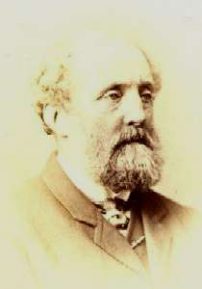Pastoralist, Mining Investor, Politician & Horseracing Identity
Location: CofE*D*171
Pearson was born on 20 September 1818 into an old Scottish family at Hilton, Kilmany, Fife, Scotland the son of Captain Hugh Pearson RN and Helen née Littlejohn. After his father’s death in 1839, he abandoned his love of the sea and attracted to stories from Tasmanian pioneers of the pastoral prospects of southern Victoria, he migrated in September 1840 on the John Cooper arriving in Adelaide in March and headed straight to the Port Phillip settlement. From there, he drove cattle into northern Gippsland via Albury and Omeo before establishing Kilmany Park pastoral run (14,500 acres) in September at the junction of the Thomson and Latrobe rivers near Sale later purchasing the freehold at auction (1868); at the time only Angus McMillan (Sale Cemetery) and his party of explorers had settled in the area.
Other pastoral stations owned by Pearson devoted to cattle raising were Marysville (22,900 acres); Hill End (23,000 acres); Tangel Hills (15,300 acres) and Grass Hills (15,300). Yet it was the decision to become the largest investor in the famous Long Tunnel mine at Walhalla, Victoria in June 1865 that made Pearson wealthy; his 900 shares purchased at £5 each soon rose to £212 paying dividends of £512 a share over the next forty years. “Aristocratic in looks and stern in demeanour”, he went on to represent the area in the Legislative Assembly (1864-67) and the Legislative Council (1881-93); The Argus noted that Pearson was “not by any means a demonstrative man in politics, he was one of the class of legislators who are steadfast in their devotion to principle”.
The most prominent of racing men of his time reputed to have won over 300 races, in 1887 he came within 20 guineas of owning the great Carbine – “the greatest horse Australia ever saw” – yet in fourteen attempts Pearson never won the Melbourne Cup having failed with Prince (1861) in the first Cup; Viscount (1865 & 1866); Sparrowhawk (1866 & 1867); Kestrel (1869); Contessa (1872); Dolphin (1873); The Czar (1881); Commotion (1883, 1884 & 1886); Magnet (1883); Plausible (1884 & 1885); Arsenal (1885) and Firelock (1890 & 1891). A foundation member of the Victoria Racing Club (VRC) on 10 March 1864, by far his greatest horse owned was Commotion (“the Carbine of his day…perhaps the stoutest horse that ever ran in Australia”) who in 1884 won the Canterbury Plate, the Bagot Plate, Midsummer Handicap, the Essendon Stakes and the Champion Stakes; a heavy better he thought nothing of laying £1,000 on one of his horses.
Pearson died from heart disease at his home Craigellachie – 2B Lynedoch Avenue, East St. Kilda on 10 August 1893 survived by his wife Eliza née Travers (d 1896) whom he married on 4 August 1859 and bore him seven children; Hugh (1860-74), Henry (1861-80), William (1864-1919; married Sophie née Gooch, 1887), John (1866-1925; married Olive née Gooch), Alexander (q.v.) (1869-1920), Helen (1871-91) and Laura (b 1874; married Percy Miller). Pearson’s estate was valued for probate at £196,500.
Source:
ADB Volume 5 1851-90 (K-Q).
The Argus 15 October 1849 & 11 August 1893.
The Australasian 2 February 1867, 12 August 1893 & 23 September 1893.
The Age 11 August 1893.
Thomson, K & Serle, G., “A Biographical Register of the Victorian Legislature 1851-1900” (1972).
Henderson, A., “Henderson’s Australian Families” (1941).
Corfield, J & Persse, M., “Geelong Grammarians. A Biographical Register Vol I 1855-1913” (1996).
Pacini, J., “A Century Galloped By. The first hundred years of the Victoria Racing Club” (1988).
(Image reproduced with kind permission of the Victorian Parliament Library)

